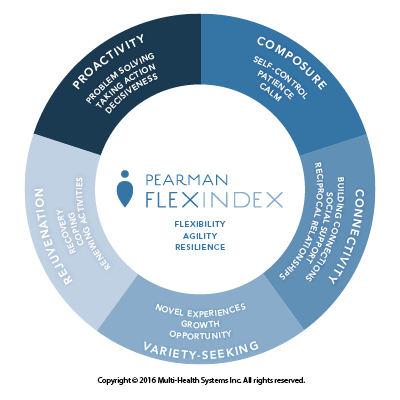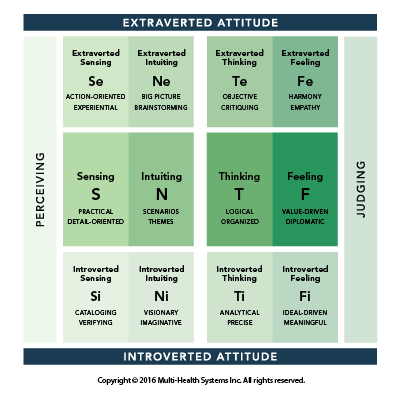Personality Type and Leadership with Dr. Roger Pearman
Despite the prevalence of personality type tests, which classify individuals into categories, identifying characteristics they either lack or possess, there is little application of the concept of personality as fluid. In his article on using mental resources, Dr. Roger Pearman shares that one of the challenges in using one’s “mental engine” is understanding the entirety of it and using parts of it we tend to ignore. It is important to recognize that an individual’s personality does not change, but one can learn and adapt to new behaviors if given the opportunity to explore their mental resources.
The Pearman Personality Integrator® (Pearman™) is an innovative assessment made up of two components: Pearman Personality and Pearman FlexIndex. The Pearman Personality reflects an individual’s natural and demonstrated personality types, and the Pearman FlexIndex evaluates one’s psychological flexibility and agility skills. The Pearman drew upon Carl Jung’s personality type theory during its development. It describes an individual’s personality type based on eight mental functions:
- Extraverted Sensing and Intuiting
- Introverted Sensing and Intuiting
- Extraverted Thinking and Feeling
- Introverted Thinking and Feeling
According to Dr. Pearman, author of the Pearman Personality Integrator, “personality type helps us get a practical handle on our natural strengths and biases, on our habits of mind and our lacunas, and by being more conscious of these, we can live more fully.” Dr. Pearman is a Certified Executive and Team Coach, and a Consultant for Talent Acquisition and Development services. He is the Managing Partner at TalentTelligent, LLC, and co-author of various publications, including his most recent publication: I’m Not Crazy, I’m Just Not You.
The interview below has been edited for length and clarity.
How did you begin your work in exploring the nature of personality type?
ROGER: In 1974, I was exposed to Carl Jung’s Theory of Psychological Types. In my first professional role as the Director of the Learning Center for Wake Forest University, I used the lens of psychological type to help students understand their different learning communication styles.
As I took on different roles in my professional career, I used psychological type in coaching executives, building teams, and in researching the question of the relationship between psychological type and individual effectiveness, which set the stage for the work that would become the Pearman Personality Integrator. Throughout my professional and personal life, I have found personality type a constructive way to work with differences and to celebrate the differences of those around me.
Tell us how you define the difference between natural and demonstrated personality?
ROGER: One of the most perplexing issues in the measurement of personality is the challenge of identifying what an individual feels is their “natural” way of operating in the world and what may be required by virtue of context. No matter what personality tool individuals are exposed to, the perplexity emerges: But this is what I have to do in my situation, not what I feel most comfortable doing. It makes sense to ask both questions:
- What is comfortable to you as a natural expression of who you are?
- What must be demonstrated given your context?
An individual may say: “I am comfortable working on specific projects and working out the analysis of an issue. However, I am also required to present my findings and argue for more support on projects.” This individual performs on the latter requirement out of necessity, not because it is a natural task for them to do. “Natural” is what one feels is reflective of their true self. “Demonstrated” is what one shows to the world by virtue of the context they are in.
Why is it important for an individual to flex their personality to changes in their environment?
ROGER: Personal efficacy and overall fulfillment are tied to the capacity to flex and do so efficiently—less energy being consumed to respond to shifting environmental demands. Individuals who have difficulty flexing in their situations have higher degrees of stress, more intra- and interpersonal conflicts, and face barriers in achieving their goals. Flexibility has a number of parts to it, and all of them can be understood and enhanced through coaching and training. The more we build up these aspects of flexibility, the more capable we are of flexing when needed. It takes energy to shift psychologically and developing skills that build our energy reserves allows us to respond as needed.
A closer look at the eight mental functions reveals an important layer worth considering. The eight mental functions are a framework for understanding complex psychological processes. There are four mental functions associated with ways of perception and four functions associated with ways of decision-making. These functions provide us with a means of enhancing our perceptions. We may find that we flex easily among ways of perceiving and not so easily with ways of making decisions. Fortunately, there are ways to enrich both.
For example, an individual may be especially adept at reading the physical environment (Extraverted Sensing) and sharing or expressing patterns and associations of objects being seen (Extraverted Intuiting). This ease of shifting helps reduce blind spots about things in the surrounding environment. However, the same individual may be called upon to analyze and critique those objects being seen (Introverted Thinking) and prioritize what to pay attention to first (Introverted Feeling). There are at least two additional mental shifts that are occurring in this situation—shifting from perceiving related energies (Extraverted Sensing and Extraverted Intuiting) to decision-making processes (Introverted Thinking and Introverted Feeling), and then between two kinds of overarching processes (Thinking and Feeling). An individual with high flexibility can easily switch between perception and decision-making.
Figure 1: Diagram of The Pearman’s Eight Mental Functions
Tell us more about the Pearman and why is it unique to personality type testing?
ROGER: Unlike other personality-related tools, the Pearman assumes that all eight mental functions are available to everyone. Other tools operate on a deficit mode—you have a trait or an attribute, or you don’t, and you might have to work to develop it if you don’t. The eight mental functions are resources we have, and we can enrich them through experience. The question is how we might use them. If we can identify and access our mental resources with greater awareness, we can enhance ways of perceptions and judgments and in doing so, increase personal effectiveness.
Second, the Pearman acknowledges that there can be differences between our natural way of being in the world and what the world requires of us. Those differences can be energizing or energy depleting. It is a tremendous relief to individuals to know that the tension they may be experiencing is a result of a difference between what is natural and what is required, enabling constructive action to address and reduce the tension.
Third, the Pearman invites the individual to identify and enrich the sources of flexibility needed to move through life with well-being and resilience in mind. Knowing how flexible we are as a whole is important, but knowing which aspect of flexibility needs enrichment is vital.
Can you speak more on the importance of the FlexIndex for improving transformational leadership?
ROGER: If transformational leadership is about how a leader works with others beyond their immediate self-interests to identify and execute changes towards an objective goal, then being at maximum flexibility matters. Leaders engaged in transforming teams must be able to flex to the needs of different groups and maintain a high degree of energy to inspire others as needed. The notion of “transformation” is to facilitate moving from one state of affairs to another, preferably a state more effective and fulfilling. Leaders who do not have the psychological resources to flex usually fail to meet the needs of their teams, revert to their fixed mindsets resulting in less learning, and over-rely on certain habits—whether these are effective or not.
Figure 2: Diagram of The Pearman FlexIndex

How would you describe the interplay between personality and emotional intelligence competencies from a leadership perspective?
ROGER: Existing claims may state that if you have one competency, you don’t need the other, and in my experience, I have found, instead, that these are complementary—each enhancing the effects of the other. Every key emotional intelligence model I know of points out the importance of empathy and how it is demonstrated. Personality helps us understand how empathy may be experienced and expressed differently. In addition, emotional intelligence is about recognizing and regulating your own emotions, as well as being in tune with the emotions of those around you. The self-reflection offered by the Pearman supports understanding your own patterns, how others operate, and the ways in which you differ, which in turn can build empathy.
Each key element of emotional intelligence frameworks demonstrates a degree of involvement of the eight mental functions. Some connections that come to mind include:
- Extraverted Sensing facilitates reading the body language of individuals in an interaction.
- Introverted Intuiting anticipates how things will play out in an interaction and the likely needs of those in a particular situation.
For a leader to be effective, attending to the context, proposing multiple perspectives, understanding one’s emotional reactions and reading those of others, and creating a setting of psychological comfort and affirmation of what is meaningful are all core to emotional intelligence.
Learn more about the Pearman Personality Integrator.





















